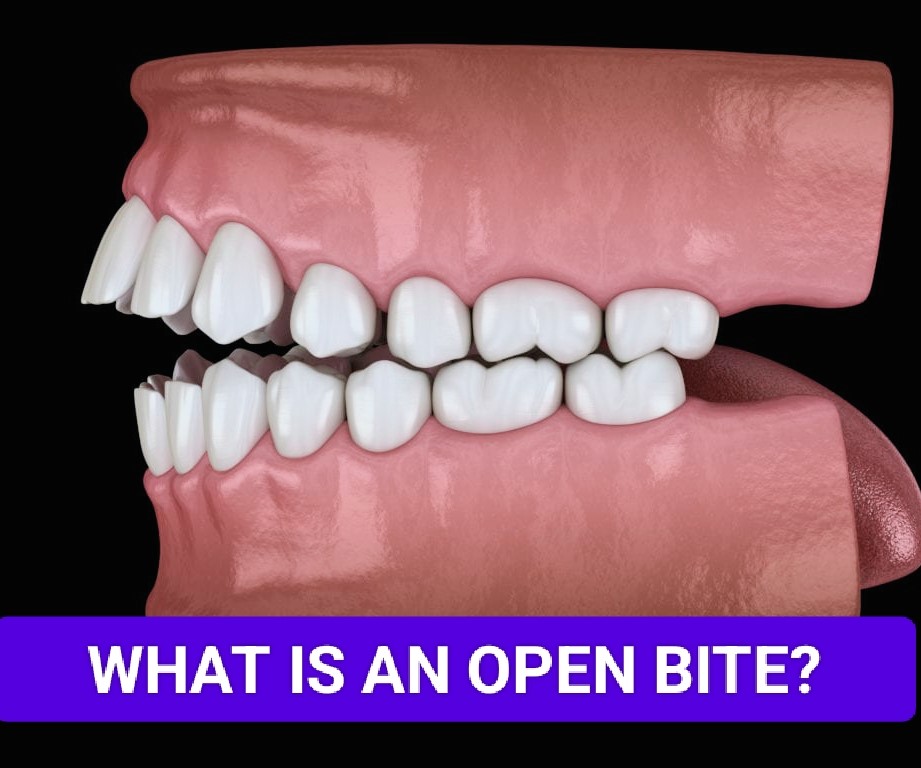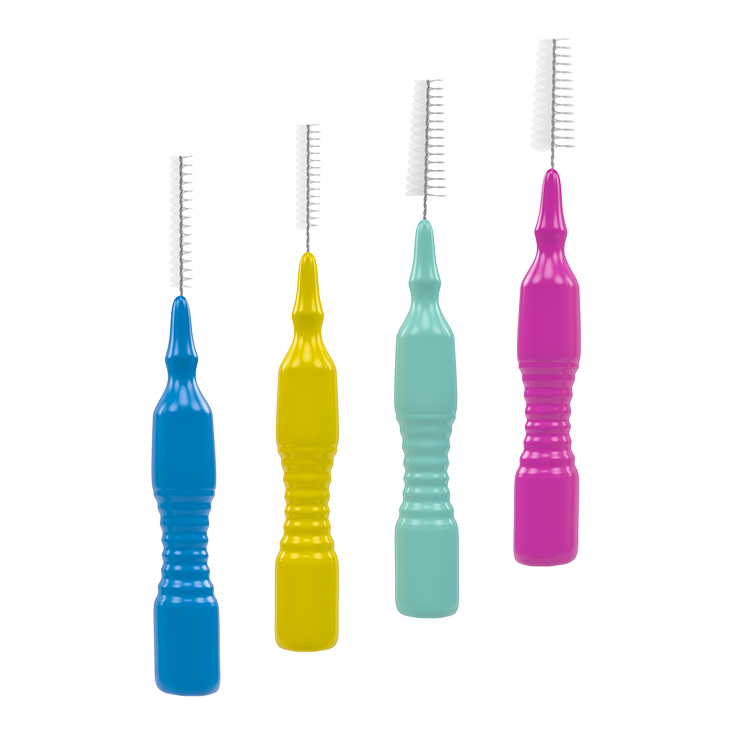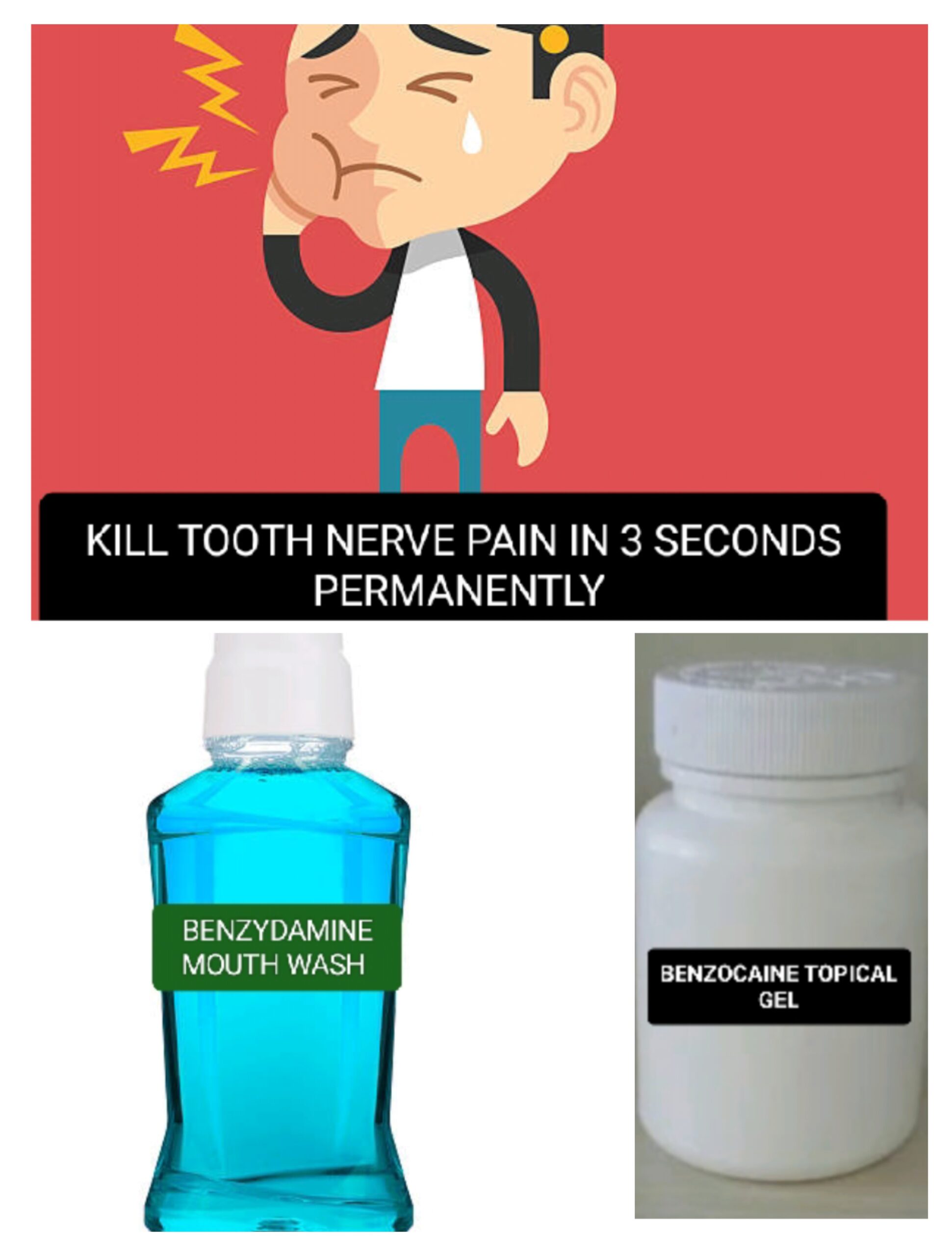An open bite is a common dental condition characterized by a gap between the upper and lower teeth when the mouth is closed. This abnormality can occur in the front of the mouth or the back, and it can lead to a host of functional and aesthetic problems. In this article, we will examine in detail what causes an open bite, its effects, and the treatment options available.

CAUSES OF OPEN BITE:
An open bite can have several causes, including genetic predisposition, thumb sucking, tongue thrusting, and abnormal swallowing patterns. Prolonged bottle-feeding and pacifier use in children can also contribute to the development of an open bite.
Genetic factors:
Studies have shown that genetic factors play a significant role in the development of an open bite. In some families, there is a predisposition to developing an open bite due to genetic factors, including jaw size and shape, and tooth placement.
Thumb sucking and tongue thrusting:
Habitual thumb-sucking or pacifier use in children can cause an open bite, particularly if the habit is not broken before the age of five. The constant sucking motion is believed to interfere with the normal teeth alignment and jaw growth, leading to an open bite. Similarly, tongue thrusting – pushing the tongue forward when swallowing – can displace the teeth, causing an open bite.
Abnormal swallowing patterns:
Swallowing patterns can also affect the developing dentition, leading to an open bite. In normal swallowing patterns, the tongue presses against the upper teeth, aiding in the formation of healthy dental arches. However, some individuals develop abnormal swallowing patterns that cause the tongue to press against the lower teeth or even thrust through the front teeth. This constant pressure can cause teeth displacement, leading to an open bite.
Jaw Abnormalities:
An adult may develop an open bite due to a skeletal abnormality such as a small lower jaw or a large upper jaw that causes the teeth to separate in the front.
TMD:
Temporomandibular disorders (TMD) can cause an open bite in adults by interfering with the normal functioning of the jaw joint, leading to jaw misalignment.
Teeth Grinding and Clenching:
Excessive teeth grinding and clenching, especially while sleeping, places undue stress on the teeth and jaws, leading to inflammation, muscle pain, and eventually, an open bite.
Gum Chewing:
Frequent gum chewing can lead to overuse of the chewing muscles, causing muscle imbalances that can contribute to open bite.
Injuries:
Injuries to the face or jaws can cause damage to the muscles, joints, and teeth, leading to an open bite.
TMJ Surgery:
In rare cases, TMJ surgery can lead to jaw misalignment or instability, leading to an open bite.
Medical Conditions:
Certain medical conditions can affect jaw development and lead to the development of an open bite. These conditions include acromegaly, a rare condition characterized by excessive growth hormone production, and Ehlers-Danlos syndrome, a genetic disorder characterized by defective connective tissue.
EFFECTS OF OPEN BITE
This condition can have several effects on a person’s oral health, appearance, and even overall well-being. Here are some common effects of open bite:
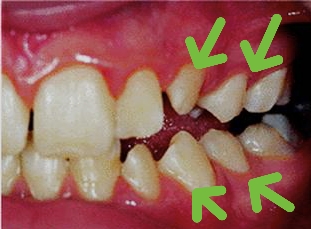
Dental problems:
Open bite can lead to various dental issues, such as difficulty in biting and chewing food properly. It may also cause excessive wear and tear on the back teeth, as they may be subjected to increased forces due to the improper alignment of the front teeth.
Speech Difficulties:
Open bite can affect speech patterns, causing certain sounds to be mispronounced or making it harder to articulate certain words. This can lead to communication challenges and may affect a person’s self-confidence.
Temporomandibular joint (TMJ) disorders:
Misalignment of the jaws due to open bite can contribute to TMJ disorders, which may cause symptoms like jaw pain, headaches, clicking or popping noises when opening or closing the mouth, and restricted jaw movement.
Aesthetics and self-esteem:
Open bite can impact a person’s facial aesthetics, particularly when smiling or speaking. The visible gap between the upper and lower teeth can affect self-esteem and confidence, potentially leading to social or psychological challenges.
Malnutrition:
In severe cases, open bite may hinder proper mastication (chewing) and digestion of food, leading to nutritional deficiencies and related health issues.
Orthodontic complications:
Open bite can pose challenges for orthodontic treatment. It may require a longer treatment duration, specific orthodontic appliances, or even orthognathic surgery in certain cases to correct the bite and achieve proper alignment.
Sleep apnea:
In severe cases, an open bite can contribute to sleep apnea, a condition where breathing stops and starts intermittently during sleep.
TYPES OF OPEN BITE
OPEN BITE IN CLASSIFIED ACCORDING TO THE TEETH INVOLVED, AS
- ANTERIOR OPEN BITE
- POSTERIOR OPEN BITE
Let’s understand each one in detail.
ANTERIOR OPEN BITE
An anterior open bite is a type of malocclusion or teeth misalignment that affects the front teeth of the upper and lower jaws. It is characterized by an insufficient vertical overlap of the incisors when the mouth is closed, leading to a gap between the front teeth. Anterior open bites can affect the quality of life of a person by causing difficulties in speech, eating, and self-esteem issues due to the highly visible nature of the condition.
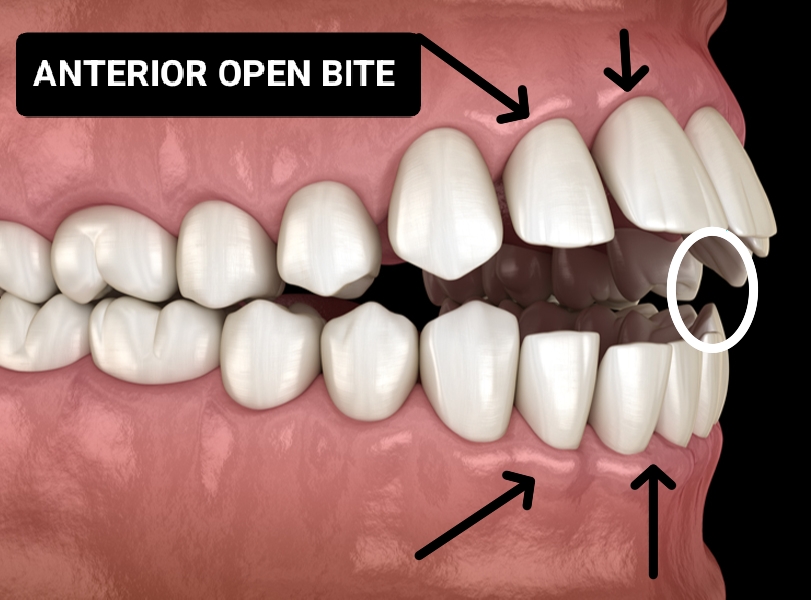
Causes of Anterior Open Bite:
1. Genetic Factors: Anterior open bites can be caused by genetic factors that lead to abnormal growth or development of the jaws.
2. Thumb Sucking and Pacifier Use: Prolonged use of a pacifier or thumb sucking can cause an anterior open bite by disrupting the proper growth of the jawbones.
3. Tongue Thrusting: An anterior open bite can also be caused by tongue thrusting where the tongue is pushed between the front teeth during speech or swallowing.
4. Mouth Breathing: Chronic mouth breathing can lead to an open bite as the tongue is not in its normal position to help maintain the alignment of the teeth.
5. Jaw Trauma: Anterior open bites can also result from jaw trauma due to injuries sustained in accidents, sports activities, or falls.
6. Temporomandibular joint disorders (TMD): TMD is a condition that causes pain and fatigue in the facial muscles, leading to anterior open bite.
Diagnosis of Anterior Open Bite:
Dentists and orthodontists can diagnose anterior open bites through a comprehensive oral examination, which may include taking measurements of the teeth and jaw, X-rays, and bite analysis. The diagnosis may also involve assessing the patient’s medical history to look for any underlying causes such as genetic disorders, thumb-sucking habits, trauma, or TMD.
Treatment of Anterior Open Bite:
The treatment of anterior open bite depends on the severity and cause of the condition. The following are some of the common treatment options.
1. Orthodontic Treatment:
Orthodontic treatment is considered the most effective way to correct mild to moderate anterior open bites. The treatment involves the use of braces or clear aligners that exert pressure on the teeth and jaws, leading to their gradual realignment into their proper position.
2. Maxillofacial Surgery:
In cases where the bone structure of the jaw is severely affected, maxillofacial surgery can be performed to reposition the jaws and correct the open bite.
3. Speech Therapy:
Speech therapy can also be used in conjunction with other treatments to address any speech difficulties that may result from the anterior open bite.
4. Tongue Thrust Therapy:
Tongue thrust therapy involves training the tongue to move correctly and to rest in the correct position to help correct the anterior open bite.
Prevention of Anterior Open Bite:
The following are some of the measures that can be taken to prevent anterior open bite.
1. Limiting Pacifier Use and Thumb Sucking:
Parents should discourage prolonged pacifier use and thumb sucking in children to avoid disruption of proper jaw growth.
2. Early Detection:
Early detection and treatment of anterior open bite can help prevent or minimize the severity of the condition.
3. Good Oral Habits:
Maintaining good oral hygiene, correcting any speech difficulties, and breathing through the nose are essential in preventing anterior open bite.
Conclusion:
Anterior open bite is a common malocclusion that can occur due to various factors, including genetics, thumb-sucking, tongue-thrusting, jaw trauma, and TMD. While it can affect the quality of life of a person, it is a treatable condition through various options such as orthodontic treatment and maxillofacial surgery. Early detection and prevention are key in avoiding the development or minimizing the severity of anterior open bite.
POSTERIOR OPEN BITE
A posterior open bite is a type of malocclusion or teeth misalignment that affects the back teeth of the upper and lower jaws. It is characterized by an insufficient vertical overlap of the posterior teeth (molars), leading to a gap between the upper and lower posterior teeth when the mouth is closed. Posterior open bites can cause difficulties in chewing and result in abnormal wear and tear of the teeth. The following are some of the causes, diagnosis, and treatment of posterior open bites.
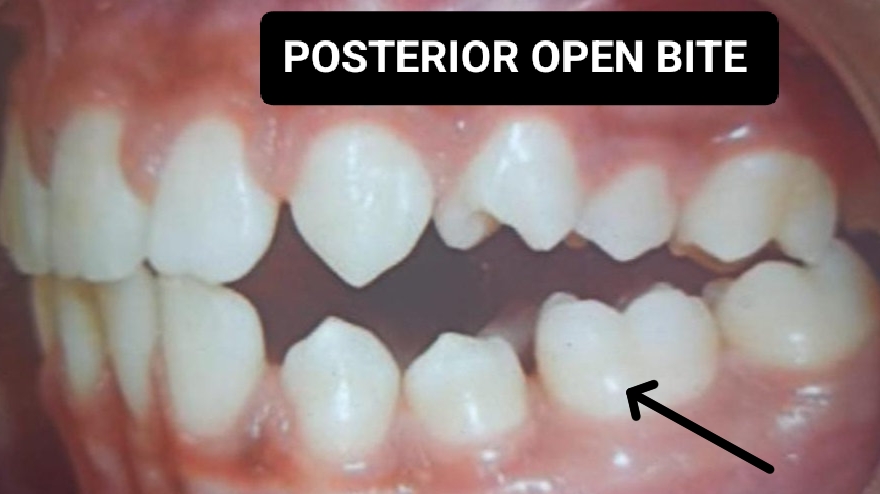
Causes of Posterior Open Bite:
1. Genetically Inherited Traits: Posterior open bites can be caused by genetically inherited traits that lead to abnormal growth or development of the jaws.
2. Thumb Sucking and Pacifier Use: Prolonged use of a pacifier or thumb sucking can cause a posterior open bite by disrupting the proper growth of the jawbones.
3. Tongue Thrusting: A posterior open bite can also be caused by tongue thrusting where the tongue is pushed against the back teeth during speech or swallowing.
4. Temporomandibular Joint Disorders (TMD): TMD is a condition that causes pain and fatigue in the facial muscles, leading to a posterior open bite.
Diagnosis of Posterior Open Bite:
Dentists and orthodontists can diagnose posterior open bites through a comprehensive oral examination, which may include taking measurements of the teeth and jaw, X-rays, and bite analysis. The diagnosis may also involve assessing the patient’s medical history to look for any underlying causes such as genetic disorders, thumb-sucking habits, or TMD.
Treatment of Posterior Open Bite:
The treatment of posterior open bite depends on the severity and cause of the condition. The following are some of the common treatment options.
1. Orthodontic Treatment:
Orthodontic treatment is effective in correcting mild to moderate posterior open bites. The treatment involves the use of braces or aligners that exert pressure on the teeth and jaws, leading to their gradual realignment into their proper position.
2. Maxillofacial Surgery:
In cases where the bone structure of the jaw is severely affected, maxillofacial surgery can be performed to reposition the jaws and correct the open bite.
3. Referral to a Speech Therapist:
A referral to a speech therapist may be necessary to help address any speech difficulties that may result from the posterior open bite.
4. TMD Treatment:
Treatment options for TMD, such as muscle relaxation exercises and splints, can also help alleviate the symptoms of posterior open bite caused by TMD.
Prevention of Posterior Open Bite:
The following are some of the measures that can be taken to prevent posterior open bite.
1. Limiting Pacifier Use and Thumb Sucking:
Parents should discourage prolonged pacifier use and thumb sucking in children to avoid disruption of proper jaw growth.
2. Early Detection:
Early detection and treatment of posterior open bite can help prevent or minimize the severity of the condition.
3. Good Oral Habits:
Maintaining good oral hygiene, correcting any speech difficulties, and breathing through the nose are essential in preventing posterior open bite.
Conclusion:
Posterior open bite is a common malocclusion that can occur due to various factors, including genetics, thumb-sucking, tongue-thrusting, and TMD. While it can affect the quality of life of a person, it is a treatable condition through various options such as orthodontic treatment and maxillofacial surgery. Early detection and prevention are key in avoiding the development or minimizing the severity of posterior open bite.
It’s important to note that the severity and specific characteristics of an open bite can vary from person to person, and the effects mentioned above may differ in each case. If you suspect you have an open bite or any other dental condition, it’s recommended to consult with a qualified orthodontist or dentist for a thorough evaluation and appropriate treatment options.
FAQs
Here are some frequently asked questions about open bite:
Q. What causes an open bite?
A. An open bite can have various causes, including genetics, thumb sucking or pacifier use during childhood, tongue thrusting habits, prolonged bottle feeding, airway obstruction, skeletal abnormalities, or a combination of these factors.
Q. Can an open bite correct itself without treatment?
A. In most cases, an open bite will not correct itself without intervention. Early orthodontic intervention or orthognathic surgery may be necessary to correct the bite and achieve proper alignment.
Q. Can orthodontic treatment fix an open bite?
A. Yes, orthodontic treatment can often correct an open bite. Braces, aligners, or other orthodontic appliances are commonly used to gradually move the teeth into proper alignment. In more severe cases, orthognathic surgery may be required in combination with orthodontic treatment.
Q. At what age should open bite be treated?
A. Treatment for open bite is often initiated during childhood or adolescence when the jaws and teeth are still developing. Early intervention can help guide the growth and alignment of the teeth and jaws, making treatment more effective. However, open bite can also be treated in adults with appropriate orthodontic and surgical approaches.
Q. Are there any non-surgical treatment options for open bite?
A. Non-surgical treatment options for open bite depend on the individual case. Orthodontic treatment, such as braces or clear aligners, is a common approach. Additionally, behavior modification techniques may be used to address habits like thumb sucking or tongue thrusting that contribute to the open bite.
Q. Is open bite only a cosmetic issue?
A. No, open bite is not just a cosmetic issue. It can have functional implications, such as difficulty biting and chewing food properly, speech difficulties, and potential TMJ disorders. Additionally, the aesthetic aspect of open bite can impact a person’s self-esteem and overall well-being.
Q. Can I fix an open bite with exercises or orthodontic appliances I find online?
A. It’s not recommended to attempt self-treatment using exercises or orthodontic appliances found online. Open bite is a complex dental condition that requires a professional evaluation and treatment plan tailored to your specific needs. Consulting with a qualified orthodontist or dentist is crucial to ensure proper diagnosis and appropriate treatment.

